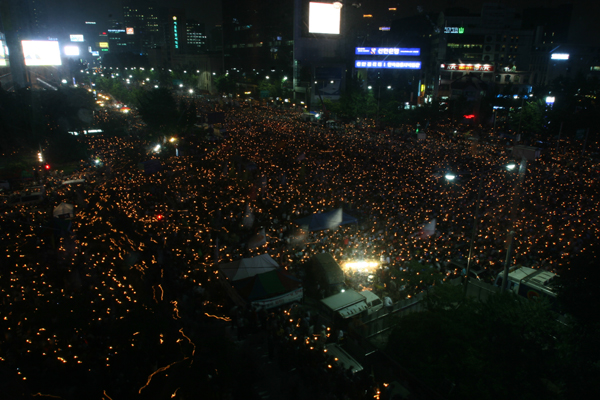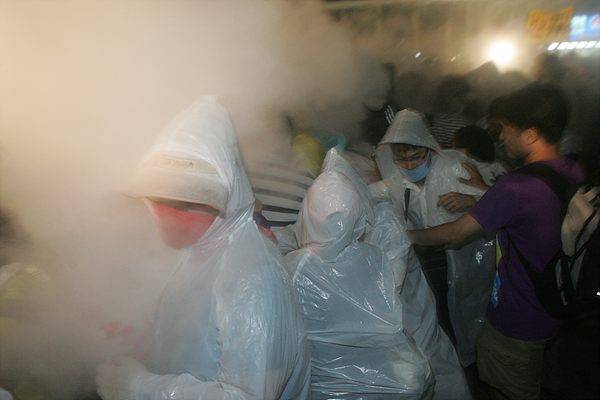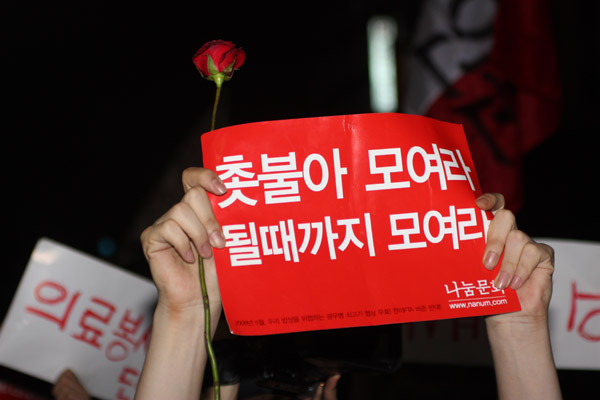all text articles
Mass movement halts the neo-liberal bulldozer
Chris Kerr
 |
 |
The newly elected neo-conservative regime of President Lee Myungbak has been humbled by the spontaneous emergence of a mass movement, which was sparked by female middle school and high school students, but which has seen the largest and longest sustained demonstrations since the fall of the military dictatorship. The mass protests are primarily against the imposed resumption of the importation of US beef but have, in the course of their development, tapped into latent anger of the Korean population against the implementation of the government’s neo-liberal agenda.
In April this year, Korean President Lee, before meeting George Bush in his Texas ranch, agreed to lift all existing bans on US beef which were imposed in 2003 after a case of mad cow was detected, especially beef over 30 months old which is considered to be more susceptible to mad cow disease.
The move was unpopular due to the perceived scientific risks that it posed to the Korean population and because the Korean market already had found a suitable alternative in consuming its own beef along with the importation of Australian beef.
It is also a strong cultural symbol of class division as the elite of Korean society, that are the vocal supporters of the beef agreement, do not dine on US beef as they are wealthy enough to eat the much preferred but expensive domestically produced beef. On the other hand, the rest of the Korean population will be forced to eat US beef.
However, the Korean market is of high importance to American beef producers (as it was the 3rd largest before the bans were imposed) and the lifting of the beef bans has been tied by the Democrat-controlled US congress as a precondition for the congressional ratification of a Korea-US Free Trade Agreement which has already been signed by the Korean and US administrations.
In response to the agreement, a relatively small group of Korean female middle school and high school students who organized themselves through the internet organized a daily candle-light vigil outside City Hall.
The Beginning
These students were also motivated to protest by a series of proposed educational reforms designed to foster greater competition among already exhausted school students (a common day for an average Korean high-student usually requires a study schedule of 7am-1am) as well as strengthen the elite schools but kept their demands to the issue of US beef.
 |
These protests drew media attention as well as a large amount of sympathy from Korean society. Thus, in the world’s leading internet-infrastructure nation, what became known as a ‘netizens’ movement spontaneously emerged. The open space of the internet drew out an enormous amount of criticism and debate about the government’s policies as well as creativity in how they should be opposed.
The ‘netizens’ movement was able to draw in large amounts of people from the broader layer of society into the protests. These protests grew in number and climaxed on June 10th - the 21st anniversary of the demonstrations that led to the overthrow of the military dictatorship - to attract around 700, 000 demonstrators.
In contrast to demonstrations that were characteristic of the Korean movements in the 1980’s and 90’s these demonstrations were more festive and less militant in their character. Instead of including just organized labour, student and social movements, these candle-light vigils were filled with families and people from all ages and backgrounds. Not only was this new movement not led by the more traditional protest leaders but in some ways it actually acted to revitalize them as they were demoralized from the lost battle against the FTA as well as the emergence of the Lee Myungbak regime.
Dynamics
However, it would be wrong to characterize the candle-light vigil demonstrations simply as a homogenous movement around a simple issue. As these demonstrations were rather spontaneous in their development, they have been both heterogeneous and extremely fluid in its internal dynamics. While at first, there existed a rather clear dichotomy between the ‘netizens’ and ‘activists’, through the course of struggling together, and despite strong debate and the existence of cultural differences, there has been a deepening convergence between the old and new tendencies.
What also occurred in these demonstrations was the broadening of the issues brought in by participants. Where as, the surface issue is beef, demonstrators began producing placards, and chanting slogans that also focused on President Lee’s subservience to the US government and his neo-liberal program of privatization of the health care, of education, of water and electricity as well as his plan to build a canal in a geographically small nation that is a peninsula surrounded by water but which already enjoys highly developed transportation infrastructure. President Lee’s empty but popular electoral slogans were dissipating as his specific policies came under the spotlight and increasing scrutiny.
The upshot of these demonstrations was a major crash in support of the Lee government from 75% in February to 17% in June. Some internal government polls even saw his popularity plummet to 7%. The government went into emergency mode and attempted a number of symbolic gestures to rebuild support. It first attempted a mass resignation of all ministers involved in the signing the accord. It sent negotiators to the United States in order to stop beef over 30 months old to be imported. President Lee, who has built a reputation as a strong-armed leader who took pride in his reputation of ignoring opposition and ‘getting things done’ thus referred to in the
Korean media as ‘the bulldozer’ was humbled into making two separate nationally televised apologies where he expressed remorse for not listening to the concerns of the Korean people and promised to change.
 |
▲ container boxes blocking protesters from government comlex |
However, the US congress did not back down and after much wrangling merely offered a temporary voluntary agreement by US farmers not to export beef over 30 months without writing this condition into the accord..
The Korean movement didn’t accept this concession as continued its protests with the government’s tone and response then changing dramatically. President Lee proclaimed all that could be achieved had been done and that all demonstrations needed to cease immediately as it was hurting the economy and paralyzing Korean society. Where the government was originally dismissive and then apologetic towards the movement it made a strategic decision to crush it with force ? with the infamous Korean police state reemerging from the shadows of the democracy era. Starting from late June, the government directed the police to heavily repress the demonstrations resulting in hundreds being arrested and injured through police brutality.
Provocation and Revitalizing Public Support
However, the militant traditions of the Korean student and labour movement allowed the movement to stiffen its resistance to the police violence and respond in kind. The corporate media then ignored the police provocations and only focused on the militant actions of the demonstrators in removing police barricades and taking the riot police head on.
 |
▲ Police are spraying fire extinguisher |
 |
 |
▲ Police are spraying water canon |
This allowed the government to isolate the movement and increase the violence of the state forces and drawing in the militant sectors into an escalation of violent confrontations while isolating the movement through the mass media. This tactic worked to an extent with polls showing that while Korean people opposed the imports of Korean beef they also wanted to see the demonstrations stop if they became too violent.
But another unforeseen twist occurred that again changed the balance of forces. Just when it appeared the movement was trapped and on a downturn -a group of well known progressive Catholic priests that had also played an important role against the military dictatorship intervened by inserting themselves as a buffer between demonstrators and police. They also supported all the demands of the movement as well as calling for the resignation of the chief of police over the police violence.
 |
 |
This inspired progressive Protestant priests to do the same followed later by Buddhist monks (that are under a general ideological war from the Christian fundamentalist President). This has given physical breathing space to demonstrators as well as revitalized public support for their causes. The latest mobilization drew hundreds of thousands of people again with many fearing that President Lee will return to the authoritarian style of his ideological predecessors during the military dictatorship era.
What has also occurred is the participation of the union movement. At one point, the Korean government ordered the national distribution of US beef that had accumulated in various ports but faced the opposition of waterfront workers who refused to allow it. In the last week, around 45 000 workers, from President Lee’s old company Hyundai, went on a two hour walk-out in solidarity with the protesters.
CEO president in the mire
However, President Lee’s position is becoming increasingly difficult. He was elected in a landslide victory last year with a historically low voter turn-out. His specific neo-liberal policies were not show-cased but rather grand promises combined with empty slogans. His main electoral slogan was “Lee Myungbak will definitely revive the economy” with the details being he will achieve 6% economic growth in his first year while in the long term doubling the average income of the Korean people and making it the world’s 6th largest economy. While the economic growth of Korea has been adequate under the previous regime it came at the expense of a major internal redistribution of wealth and a large social polarization which has created a very large sense of economic insecurity for the working and increasingly squeezed middle-classes.
Lee has also created a reputation, from being a successful CEO of Hyundai of having an indomitable will, but also someone who accomplishes important achievements and who will be able to lead the country into the future. In this context Lee was able to jump on the discontent with the so-called “left” government of ex-President Noh Moohyun and create what appeared to be a monolithic victory. This was reinforced with the general elections, which delivered a strong majority to his Han Nara (One Nation) Party, and well as the fracturing of the neo-liberal opposition parties and the Democratic Labour Party. The appearance however was subsequently betrayed by the fluid nature of Korean politics.
Lee needed to build momentum quickly in reviving economic growth and the central piece to his initial program was implementing a Free Trade Agreement with the United States. The Korean ruling elite is haunted by the spectre of Chinese capitalism that its former economic success based on a model of autonomous state-capitalist export oriented development is now being usurped by the rise of China and that Korea will need to move away from obsolete autonomous economic development to creating a new niche in the world market through information technology and other services.
The FTA agreement will give large advantages to the giant Korean conglomerates (known as Chaebol) but spell disaster for many other aspects of the economy that couldn’t compete with the United States. Being materially and ideologically tied to big business, Lee sees the mass accumulation of capital as the motor of the new economy, thus requiring not only a FTA but also a program of mass privatization and tax cuts for big business.
However, unlike the two previous administrations which had many important cadre recruited out of the democracy movement, Lee surrounded himself with close allies, spokesmen of big business and the fundamentalist Protestant Church that he attends. Where as the previous two regimes were able to use their organic links to the democratic movement to co-opt and largely keep the population demobilized President Lee enjoys no such capacity.
The upshot being that the first real major initiative that he attempted to implement faced major opposition. Furthermore, this opposition didn’t emerge from the established movements but from the ranks of previously inactive people, thus making it more difficult to control.
The Free Trade Agreement with the United States cannot be implemented without the prior implementation of the beef agreement. And if the US congress doesn’t implement it before the end of the Bush regime, it is quite likely that it will not get implemented at all as the likely next US president Barak Obama has proclaimed that it’s too favorable to Korean industrialists and will need to be reviewed.
Consequently it is imperative for President Lee to implement the beef accord. But it has come at the cost of a losing all political momentum for future privatization projects as well as a general and strong disenchantment with the administration over its policies and authoritarian method of dealing with dissent. It has also led to a revitalization of the activist movements which will now have much greater confidence to resist the neo-liberal agenda of President Lee. It has also led to a new form of activism that has transcended the previous traditions born as a product of having to work underground but not effective in building the movement today. The emergence of the mass movement and its confrontation with the state has already begun to scare away foreign investment and the economic paralysis has contributed to a significant increase in inflation with all economic factors doing worse under the current administration than under the former, thus negating President Lee’s basis for a policy blank cheque to do as he pleases.
Unforeseen Trajectory
As there is no central leadership of this movement it’s very difficult to gauge its future direction or even what will happen in the near future. It is clear that this is not merely a replay of the same political dynamic of earlier movements. The lack of popularity in Lee Myungbak has not translated into a significant increase in support of the traditional opposition political parties. The phenomena is dynamic and constantly evolving along with the consciousness of those involved.
 |
Each new development - and especially the future trajectory - is largely unforeseen by analysts and even activists. No one is sure how successful the movement will be in stopping the importation of American beef but it has certainly fractured the seemingly monolithic aura of President Lee and his neo-liberal bulldozer and will perhaps spark a new generation of class struggle in South Korea.
Real editing time : July 9, 2008
Registration : July 9, 2008
Registration : July 9, 2008
trackback URL http://www.newscham.net/news/trackback.php?board=news_E&nid=48751 [copyinClipboard]


